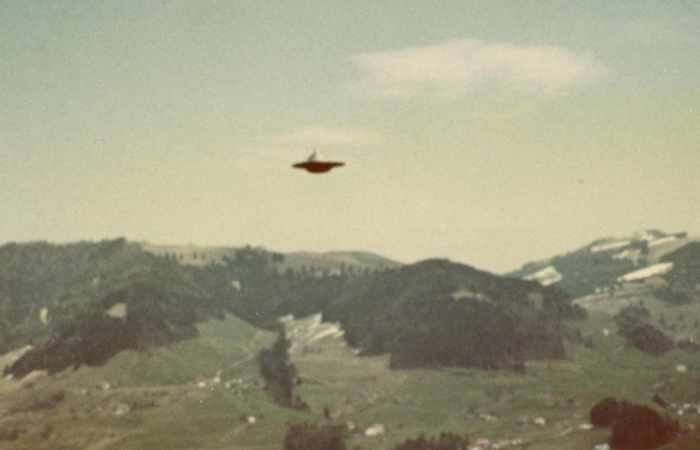“But they are spilling into the mainstream to an extent we have not seen. Now that anyone can pass on conspiracy theories to numerous others via the web, the potential for them to be disseminated has exploded exponentially.”
The centrepiece of Conspiracy Week is an exhibition called Divisive Moments, which draws upon the archives of Wendelle C Stevens (1923-2010), a former US Air Force pilot and prominent UFO research pioneer. During his 50-year career, Stevens amassed one of the world’s largest collections of UFO photographs.
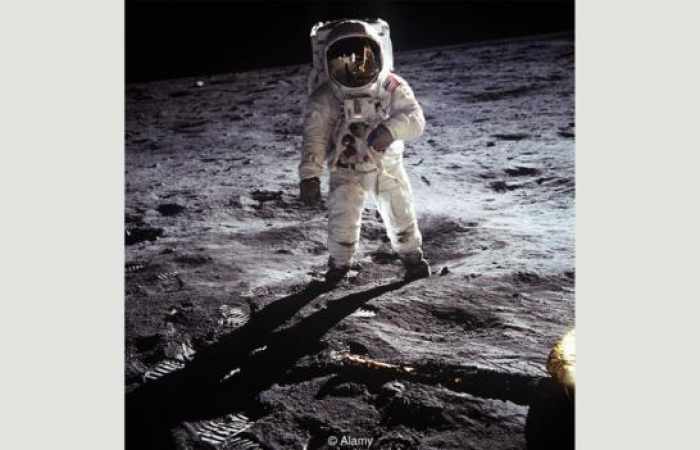
Photographs that have led to conspiracy theories include those of the moon landings and Mars (Credit: Alamy)
“We felt that the UFO story was a softer way to introduce a debate about current issues,” explains Grafik. “There’s a sense now that, if the world doesn’t fit your view, you can create your own reality through the web, where forums foster enclosed debates. You no longer have to subjugate your own opinion to the realities of the world.”
This encourages the proliferation of conspiracy theories, Grafik says. She also believes that the prominence of conspiracy theories is a factor in the changing face of global politics: “You could even say that Donald Trump has come out of this new culture of conspiracy theory – that the explosion of conspiracy on the web has made a figure like him possible.”
Who do conspiracy theories appeal to? “People who feel that the world isn’t providing them with the reality they want,” Grafik says. “In a world that seems overwhelming and complex, it’s attractive to find a narrative that somehow ties things down – even if that narrative is, to other people, completely outlandish. There’s a natural human instinct to try to make sense of things, in whatever way you can.”
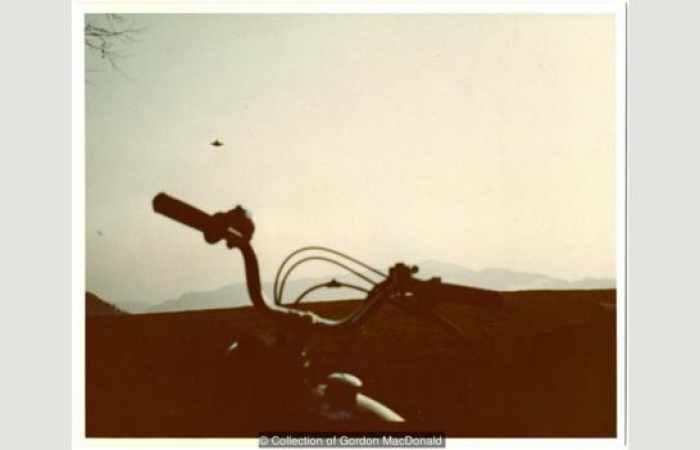
Wendelle C Stevens amassed one of the world’s largest collections of UFO photographs, including this image by Billy Meier (Credit: Collection of Gordon MacDonald)
Moreover, within the murky world of conspiracy theories, photography plays a crucial role. Many conspiracy theorists construct arguments based on ‘evidence’ offered by photographs in the public domain, which they endlessly analyse and debate.
“This is because photographs are the most accepted form of eyewitness evidence,” explains Gordon MacDonald, curator of Divisive Moments. “The intervention of a machine [ie a camera] gives photography the illusion of unbiased observation. And, of course, photography is very easy to distribute and consume: it’s easy to skim over the information in a photograph, whereas reading text requires effort.”
Of course, the idea that the camera never lies is demonstrably untrue. Here, we select five photographs commonly used by conspiracy theorists and people with an interest in the paranormal to ‘prove’ their beliefs.
Flying saucers

Billy Meier claimed he was in contact with aliens from the Pleiades star cluster, and had the photographs to prove it (Credit: Collection of Gordon MacDonald)
In 1979, Stevens published a book called UFO: Contact from the Pleiades. It investigated the claims of a Swiss farmer called Billy Meier who said that he was in contact with aliens from the Pleiades star cluster, and had the photographs to prove it. Stevens’s book subjected Meier’s photographs – a series of landscapes in which indistinct circular metal forms appear to float and hover against mountainous backdrops – to quasi-scientific tests. Drawing upon early digital technology, these were designed to determine the photographs’ veracity. Stevens concluded that the photographs weren’t doctored.
However, he did not consider the possibility that they were faked in other ways (for instance, Meier could have dangled his saucepan-like ‘spaceships’ from out-of-shot trees, using thin, hard-to-spot wires). “Just because photographs are real – ie real images made with a real camera – doesn’t mean they are of what the person says they’re of,” explains MacDonald. While researching ufology, MacDonald noticed a trend: “Flying saucers tend to get spotted by white males in remote areas – the Swiss Alps, deserts in Nevada, rural Argentina, Mexico – rather than by masses in urban areas. There’s never been a claim that a spaceship was spotted by 10,000 people on Oxford Street, for instance – though perhaps there will be during our show.”
Rama the alien

These images are claimed not to be of aliens, but be taken by Rama, an alien who had ‘abducted’ a Brazilian man, Joao Valerio da Silva (Credit: Collection of Gordon MacDonald)
Sightings of UFOs have been reported for decades, and photographs of aliens and spaceships are, if not 10-a-penny, then commonplace. MacDonald, though, is only aware of a single example of a photograph supposedly taken not of an alien but by one: an amiable creature from outer space called Rama, the protagonist of a little-known abduction case that supposedly occurred in the Brazilian city of Botucatu in the 1980s.
“The story is that this Brazilian guy, Joao Valerio da Silva, and his eldest son were abducted by Rama the alien on a regular basis, and taken to his home planet to have sex with the females to repopulate it,” MacDonald says. Stevens devoted a book to this, as he put it, “strange” case in which one abductee recalled that a female alien he had encountered “had a bosum [sic] like they have in India. A thing most attractive.”
Stevens also reproduced several atmospheric photographs depicting a shadowy humanoid figure whom the claimants said was their extra-terrestrial friend, Rama. There was even a peculiar photograph of the lower half of da Silva’s face, featuring his bushy moustache, that was, they said, taken by Rama himself. “What’s considered photographic proof is an odd thing,” says MacDonald. “Lots of people claim to have been abducted, but someone borrowing a point-and-click camera, concealing it, and then going to an alien planet with it and taking photographs – I’ve not heard of that before.”
Moon landings
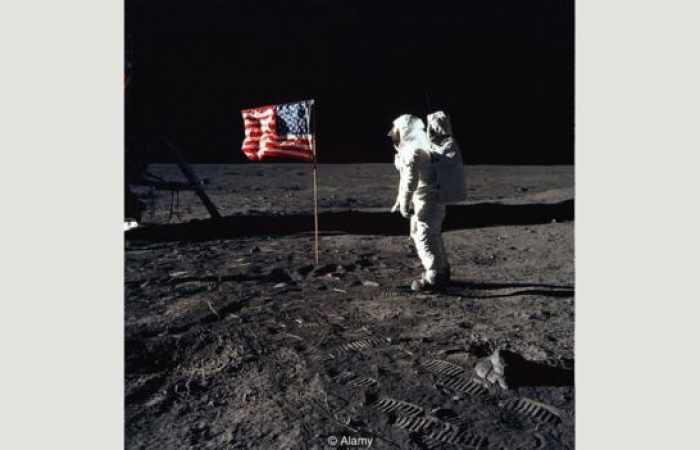
A notorious conspiracy theory centres on the Apollo Moon Landings between 1969 and 1972, and the NASA photos that some believed were faked (Credit: Alamy)
One of the most notorious conspiracy theories is that the six Apollo moon landings, which took place between 1969 and 1972, were hoaxes, and that the photographs released by NASA documenting them were faked. This idea was first given substantial form by the former US Navy midshipman Bill Kaysing, who self-published a book outlining his theory, We Never Went to the Moon: America’s Thirty Billion Dollar Swindle, in 1976.
Those who believe in the moon-landing hoax argue that NASA’s motivation for hoodwinking the world was to create the impression that the Americans had won the space race against the Russians, when, in fact, they hadn’t. “Kaysing was a well-educated man, and he believed his theory and followed it through in a very analytical way,” MacDonald says. “When you read his concerns, they seem quite coherent, which is why people believe them.” Kaysing and his followers, many of whom continue to question the moon landings today, focus on supposed peculiarities of the NASA photographs, which are freely available on the agency’s website.
MacDonald explains: “There were several contentions: that the same backdrop appears in different locations, so that it feels like a set; that shadows from boulders and astronauts run in different directions; and that too many photographs were taken, given the equipment they had at the time.” Of course, MacDonald continues, every argument has been countered by NASA – but the enduring popularity of Kaysing’s argument is significant, because it suggests an underlying motivation for conspiracy theories in general: the mistrust of governments and those in power.
“It’s the same with UFO conspiracy theories,” MacDonald says. “Often, there is an idea that governments are hiding something: look at Area 51. There’s always an ‘us and them’ angle with conspiracy theories (otherwise who would be conspiring?) – and usually it’s governments who are the ‘them’.”
Life on Mars

Images provided by NASA from the Mars Rover caused conspiracy theorists to go into overdrive (Credit: Getty Images)
Humans have speculated for a long time about the possibility of life on Mars, so when NASA released detailed images taken by the mast camera of its Curiosity robotic rover, which landed on the planet in 2012, conspiracy theorists, unsurprisingly, went into overdrive. “People see shapes, faces, pyramids, insects – all kinds of stuff – on the surface of Mars,” says MacDonald. “And much as NASA points out that there’s genuinely nothing there, that these are shadows and tricks of the light, the more the conspiracy theorists react against that voice of authority. In fact, NASA are in a constant tug-of-war with conspiracy theorists.”
While many of the claims are humorous – one photograph supposedly contains a figure resembling Elvis Presley – some have gained traction, because they seem more “convincing”. Last year, for instance, it was widely reported that within one of Curiosity’s photographs of Mars’s barren landscape, two crumbling pyramids appeared to be visible – evidence, it seemed, of a lost civilisation on the Red Planet. “The Mars conspiracy theory is interesting,” MacDonald says, “because, unlike the moon landings, it isn’t suggesting fakery, but that actual alien life is being covered up by NASA. And because people are seeing pyramids and recognisable human forms, such as statues, the suggestion is not only that alien life once lived there, but also, perhaps, that the alien life form was us.”
9/11
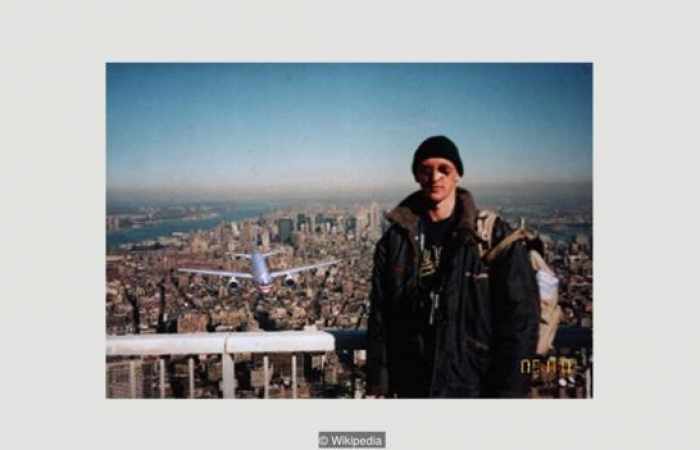
The ‘Tourist Guy’ photo was found to be a fake – it was actually taken in 1997 by a Hungarian tourist who digitally altered it after 9/11 (Credit: Wikipedia)
Some of the darkest and most extreme conspiracy theories, capable of causing maximum offence, surround the attacks of 11 September, 2001. A prominent one concerns the rapid collapse of the Twin Towers. Some people suggest that this could not have not have been caused by the impact of the planes alone, and so must have been the result of controlled explosions detonated, for sinister purposes, by the US government – possibly to provide a pretext and support for war in the Middle East.
While the 9/11 conspiracy theories have been dismissed by official investigators, those who believe them use traumatic photography of the attack and its aftermath to build their case. “In general, the most impactful photographs of the World Trade Center, like the Falling Man, are genuinely horrific,” says MacDonald. “They have been shown enough and we don’t need to see them again.”
Instead, MacDonald is more interested in a photographic hoax that emerged in the immediate aftermath of 9/11 and quickly became an early Internet sensation, circulated via email. Known as the ‘Tourist Guy’, the snapshot depicts a tourist standing on the observation deck of the World Trade Center seconds before the impact of one of the hijacked passenger airliners, which is visible behind him. “The claim was that the emergency services found a camera in the rubble and that the film inside was taken away and processed and they found the last photographs of this tourist standing on top of the World Trade Center,” MacDonald explains.
Later, the photograph was proved to be a fake – it was taken in 1997 by a Hungarian tourist who digitally altered it after 9/11, as a “joke”. At the time, though, MacDonald says, “It became one of the first really widely circulated internet hoax conspiracies. The idea that something was being covered up went around the world very quickly.” Why do people make up conspiracy theories? “It’s hard to know,” MacDonald say. “Why do people create viruses that break computers? Ultimately, it’s about sensation, and having an effect. If you release something like this into the world, you influence it. Mostly, it’s about getting recognised.”
/BBC/
More about: #art








